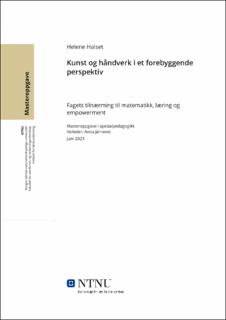| dc.contributor.advisor | Järnerot, Anna | |
| dc.contributor.author | Halset, Helene | |
| dc.date.accessioned | 2023-07-15T17:23:29Z | |
| dc.date.available | 2023-07-15T17:23:29Z | |
| dc.date.issued | 2023 | |
| dc.identifier | no.ntnu:inspera:147332166:36694070 | |
| dc.identifier.uri | https://hdl.handle.net/11250/3079522 | |
| dc.description.abstract | Hensikten med denne oppgaven er å undersøke kunst og håndverksfagets muligheter til å bidra i forebyggende arbeid, for å vinne ny innsikt i hvordan praktisk-estetiske undervisningstilnærminger kan brukes i spesialpedagogisk og forebyggende arbeid. Jeg har gjort en casestudie av en skole sin velutviklede praksis i kunst og håndverk, og har undersøkt lærernes erfaringer med matematikk i faget og hvordan faget kan bidra til utvikling av elevers empowerment. Studiets problemstilling er som følger: Hvordan kan undervisningspraksiser i kunst og håndverk bidra til empowerment, og hvordan kan fagets tilnærming til læring overføres til matematikk?
Denne problemstillingen har blitt undersøkt med empiri fra observasjoner og tre semistrukturerte intervju med to kunst og håndverkslærere og en spesialpedagog. Deres oppfatninger og perspektiver har sammen med mine observasjoner blitt undersøkt og drøftet opp mot teori om forebyggende arbeid i matematikk, selvbestemmelsesteori (Ryan & Deci, 2022), teori om mestringsforventning (Bandura, 1994), dynamisk tankesett (Boaler, 2016; Dweck, 2017) og Antonovsky sin teori om opplevelse av sammenheng (Horverak et al., 2023).
De sentrale funnene i denne undersøkelsen er at kunst og håndverk sine praktisk estetiske undervisningspraksiser kan bidra til utvikling av empowerment, ved å fremme elevers opplevelse av autonomi, kompetanse, og tilhørighet. I kunst og håndverk henger elevenes resultater tett sammen med prosess og innsats, og faget kan derfor bidra til å gi de mestringsopplevelser som kan fremme et dynamisk tankesett. Undersøkelsen har også vist at møter med matematikk i kunst og håndverk kan være med å ufarliggjøre matte gjennom fagets kroppslige tilnærminger og anerkjennelse av prosess og innsats. Likevel, har lærerne erfaringer med at elevenes kompetanse og mestringsforventning i matematikk kan skape utfordringer i kunst og håndverksundervisningen. Et tettere samarbeid med matematikk kunne derfor hjelpe elevene med overføring av kunnskap og økt elevenes opplevelse av sammenheng. I et forebyggende perspektiv kan denne kunst og håndverkspraksisen fremme utvikling av selvregulerende kompetanse og motstandsdyktighet, dermed forebygge lært hjelpeløshet og gi elevene et bedre utgangspunkt til å håndtere læring og livet. | |
| dc.description.abstract | The purpose of this study is to explore the possibilities of arts and crafts education as contributing to preventive work, to gain new insights into how practical-aesthetic teaching approaches can be used in special education and prevention. I have conducted a case study of one school's well-developed practice in arts and crafts, by studying teachers' experiences with mathematics in the subject and how the subject can contribute to the development of students' empowerment. The research question of this study is: How can teaching practices in arts and crafts contribute to empowerment, and how can the subject's approach to learning be adapted to mathematics?
This research question has been explored through empirical data from observations and three semi-structured interviews with two arts and crafts teachers and a special education teacher. Their perceptions and perspectives, along with my observations, have been examined and discussed in relation to theory on preventive work in mathematics, self-determination theory (Ryan & Deci, 2022), theory of self-efficacy (Bandura, 1994), growth mindset (Boaler, 2016; Dweck, 2017), and Antonovsky's theory of sense of coherence (Horverak et al., 2023).
The main findings of this study are that arts and crafts' practical-aesthetic teaching practices can contribute to the development of empowerment by promoting students' sense of autonomy, competence, and belonging. In arts and crafts, students' success is closely tied to process and efforts, and the subject can therefore provide students with mastery experiences that can foster a growth mindset. The study has also shown that encounters with mathematics in arts and crafts can help demystify math through the subject's embodied approaches and recognition of process and effort. However, the teachers have experienced that students' competence and self-efficacy in mathematics can create challenges in arts and crafts education. Therefore, closer collaboration with mathematics could help students transfer knowledge and enhance their sense of coherence. From a preventive perspective, this arts and crafts practice can promote the development of self-regulatory competence and resilience, thus preventing learned helplessness and providing students with a better foundation for managing learning and life. | |
| dc.language | nob | |
| dc.publisher | NTNU | |
| dc.title | Kunst og håndverk i et forebyggende perspektiv: fagets tilnærming til matematikk, læring og empowerment | |
| dc.type | Master thesis | |
